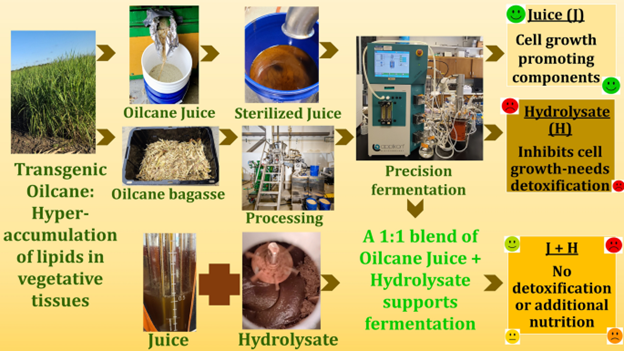Resourceful and Economical Designing of Fermentation Medium for Lab and Commercial Strains of Yeast from Alternative Feedstock: ‘Transgenic Oilcane’
Themes: Conversion, Sustainability
Keywords: Biomass Analytics, Bioproducts, Hydrolysate, Oilcane
Citation
Maitra, S., Dien, B., Eilts, K., Kuanyshev, N., Jin, Y.S., Cortes-Pena, Y.R., Guest, J.S., Singh, V. Jan. 31, 2025. “Resourceful and Economical Designing of Fermentation Medium for Lab and Commercial Strains of Yeast from Alternative Feedstock – Transgenic Oilcane.” Biotechnology for Biofuels and Bioproducts. DOI: 10.1186/s13068-025-02606-9.
Overview

Sugarcane plant engineered to accumulate lipids in its vegetative tissue is being developed as a new bioenergy crop. The new crop would be a source of juice, oil, and cellulosic sugars. However, limited tolerance of industrially recognized yeasts towards inhibitors generated during the processing of lignocellulosic biomass to produce fermentable sugars is a major challenge in developing scalable processes for second-generation drop-in fuel production. To this end, hydrolysates generated from engineered sugarcane—‘oilcane’ bagasse contain added phenolics and fatty acids that further restrict the growth of fermenting microorganisms and necessitate nutrient supplementation and/or detoxification of hydrolysate which makes the fermentation process expensive. Herein, we propose a resourceful and economical approach for growing lab and commercial strains of S. cerevisiae on unrefined cellulosic sugars aerobically and fermentatively.
An equal ratio of hydrolysate and juice was found optimum for growth and fermentation by lab and commercial strains of Saccharomyces cerevisiae engineered for xylose fermentation. The industrial strain grew and fermented efficiently under low aeration conditions having an ethanol titer, yield, specific and volumetric productivities of 46.96 ± 0.19 g/l, 0.51 ± 0.00 g/g, 0.27 ± 0.02 g/g.h and 1.95 ± 0.01 g/l.h, respectively, while the lab strain grew better under higher aeration conditions having the ethanol titer, yield, specific and volumetric productivities of 24.93 ± 0.09, 0.27 ± 0.00 g/g, 0.17 ± 0.00 g/g.h and 1.04 ± 0.00 g/l.h, respectively. Acclimation of cultures in a blended medium significantly improved the performance of the yeast strains.
The addition of transgenic oilcane juice, which is inedible and rich in amino acids, to the hydrolysate averted the need for expensive nutrient supplementation and detoxification steps of hydrolysate. The approach provides an economical solution to reduce the cost of fermentation at an industrial scale for second-generation drop-in fuel production.
Data
Download (58.4 KB) includes:
- Growth rates
- Yields and byproducts
- Sugar consumption rates
- Biomass data